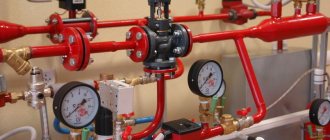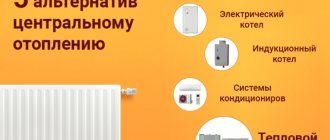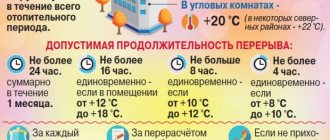With the arrival of autumn, the air outside and in apartments has become colder, so many are wondering when the heating will be turned on in 2021 - 2022. The heating season will not start soon, but preparations for it have already begun. In Russia, preparation for the next heating season begins immediately after the end of the previous one. Last winter was warm, but we're dealing with one heat wave after another, so many people are wondering when home heating will be in 2022 - read more about it.
When will the heating be turned on in 2022: laws and documents
Until recently, heating seasons in the Russian Federation were regulated by specific dates. However, due to changeable weather, this proved impractical, and in many regions the heat was not used economically.
In some regions of Russia, frosts begin in October and can continue almost until the end of spring. However, periods of warming are possible in winter. And in recent years there have been quite a lot of them. Therefore, during these periods there is no point in heating, and this leads to large overspending on heating.
The government took into account all these nuances and developed legislative documents and legal acts. These documents regulate relations in the field of heat supply. These include:
- On July 27, 2010, the Heat Supply Law (No. 190-FZ) was adopted;
Defines the competence of state and local authorities in the field of heat supply, establishes the principles of economic relations between suppliers and consumers in the field of heat supply and describes state policy on setting heat tariffs.
- Decree of the Government of the Russian Federation “On the provision of municipal services” No. 354 has been in force since May 6, 2011;
According to the document, the temperature in living rooms must be at least +18°C (at least +20°C in corner rooms). In areas where the coldest five-day temperature is -31°C or less, the temperature in living rooms should be at least +20°C (at least +22°C in corner rooms).
- SanPiN 2.1.2.2645-10 “Sanitary and epidemiological requirements for living conditions in residential buildings and residential premises.”
Appendix 2 shows the optimal and permissible indoor temperature ranges for winter and summer.
- Resolution of the State Construction Committee of the Russian Federation No. 170 of September 27, 2003. “On approval of rules and regulations for the technical operation of housing stock.”
It describes the procedure for preparing residential buildings for the winter, including the procedure for checking and testing the heating system. The work of the emergency energy service is also regulated - faults in the heating system must be corrected immediately.
All of the above documents are used by landlords and utility companies. They determine the start and end date of the heat supply.
When does the heating season begin in Russia?
The heating season is the period during which heat is supplied by central heating systems. Previously, the heating season was six months, the season began on October 15 and lasted until mid-April.
However, due to the fact that many regions of Russia experience changeable weather conditions, the start date of the 2021-2022 heating season will depend on several factors:
- Average temperatures per day;
- Weather information for the next few days.
If within 5 days the temperature does not exceed +8 degrees, the administration may issue a decree to turn off heat in the region. If necessary, the start of the 2021-2022 heating season may be changed, delayed or postponed.
Below are the start dates of the 2022 heating season in the main cities of the Russian Federation:
- Moscow - from September 25;
- In St. Petersburg from September 16 to October 1;
- In Tver, heating will begin on September 23, and on September 26, heating will be turned on in residential buildings;
- Vladimir - from September 23;
- In Yaroslavl from September 23-24 to October 1.
In Sochi, thanks to warm climatic conditions, the heating season lasts three months. Heat supply in the city is turned on on November 15 and turned off in early March.
When does the heating season end in Russia?
The 2021-2022 heating season in Russia is regulated by weather conditions, and if over the last 5 days the average daily temperature remains at +8 degrees or higher, the heat supply may be stopped.
However, due to changing climatic conditions in many regions, many local management companies are in no hurry to turn off heating; they can extend it for several weeks. The fact is that restarting the system is a rather labor-intensive undertaking, and it is better to extend the delivery time than to connect it again.
In 2022, the dates for the planned reduction in temperature in the main regions of the Russian Federation have been determined:
- April 30 - May 2;
- St. Petersburg - April 27;
- Tver - April 29;
- Vladimir - April 23;
- Yaroslavl - April 27;
- Voronezh - April 19;
- Ufa - April 30.
How many days does the heating season last?
The duration of the heating season in days is determined for different climatic zones.
The exact start and end of the heating season is indicated in the resolution/order of the head of the local administration.
In accordance with paragraph 5 of the Rules for the provision of utility services to owners and users of premises in apartment buildings and residential buildings, approved by Decree of the Government of the Russian Federation dated 05/06/2011 N 354 “On the provision of utility services to owners and users of premises in apartment buildings and residential buildings.”
The heating season must begin or end on the day following the end of a five-day period during which the average daily outside air temperature is below 8 degrees Celsius or the average daily outside air temperature is above 8 degrees Celsius, respectively.
How does this happen
Due to the nature of the central heating system, it is turned off simultaneously for objects of the same type. That is, it is impossible for the heating to be turned off in two houses belonging to the same combined heat and power plant on different days.
However, CHP workers do not turn off the heating at the same time. A sequential algorithm is used:
- Industrial facilities (factories, warehouses, etc.) and public buildings (shops, shopping centers, etc.) are the first to be turned off.
- Then residential buildings are switched off.
- The last thing to do is turn off the heating system in social institutions (hospitals, clinics, universities, schools, kindergartens, etc.).
How are preparations going for the heating season?
Firstly, local authorities, together with district heating companies, adopt regulatory documentation. Then preparations for the new heating season begin. Usually the decree on the start of work is approved by the thirtieth of April. This document defines:
- An authorized person is responsible for the maintenance and operation of all devices. Typically, this person must be an authorized person who has an advanced degree in the relevant field. He or she must undergo an annual assessment. The deputy is appointed by the same person;
- Members of the commission who will inspect and prepare heat supply facilities for operation in the autumn-winter period;
- Dates of the preparatory period (beginning and end);
- Actions that need to be taken to prepare the entire energy sector for the heating season. All actions must first be agreed upon with all parties involved in the preparation process, and only then approved;
- Procedure for monitoring and reporting on all preparatory work, checking all heat supply equipment and its readiness for connection;
- The procedure for testing and adjustment work at all objects of the heat supply system;
- Procedures for regulation and testing of all heat supply systems;
- Drawing up estimates for all upcoming repairs and replacement of outdated equipment.
Upon completion of the preparatory work, an acceptance certificate and technical passport are drawn up.
Legal subtleties and nuances when disconnecting a central heating center
There is an option to turn off the central heating without having to apply for a permit. Many of us have rarely seen contracts with utility companies for the supply of heat to your home. A priori, it is assumed that the owners of an apartment building agree with the terms of supply of centralized heating services. In fact, the situation is up in the air from a legal point of view. No contract, no obligations.
Moreover, in almost every house you can find residents who have voluntarily disconnected from the heating supply and managed to equip their apartments with autonomous heating systems. There are practically no cases of prosecution for arbitrariness in this situation, so everyone decides the situation at their own peril and risk.
Let's consider situations where, in order to make your desire to refuse centralized heating services a reality, the consent of the residents of your house and neighbors is not required.
Apartment buildings often have incomplete technical documentation regarding the heating system. In this regard, it often happens that the elements of the heating system are not part of the property complex of the buildings. Despite the fact that in such a situation you will not need to obtain collective consent to re-equip the heating systems in the apartment, official permissions from regulatory and service organizations are necessary.
The reason is that any intervention in engineering networks requires mandatory recording in technical documentation. For each house there is a technical passport, which takes into account all the data on the operating heating system. Removal of radiators, insertion and installation of plugs in apartments, any other changes must be reflected in the technical passport. Guided by Art. 26 of the Housing Code of the Russian Federation for further actions you will need the following package of documents:
- application in free form;
- registration certificate for the apartment to be switched off;
- documents confirming the right of ownership (use) of the apartment;
- written consent of all legal occupants of the apartment;
- technical conclusion of specialists on the possibility of disconnecting and subsequent re-equipment of communications.
To complete the picture, it is necessary to attach to the package of documents a reconstruction project, which is developed by specialists from the relevant organizations and authorities. The design documentation must include calculations that prove the functionality of the central heating system in the house in the absence of elements of the disconnected apartment. In addition to the project, it is better to have a scheme for thermal-hydraulic calculations of the facility and an accurate calculation of residual heating.
A technically competent project is the first step towards obtaining permission. However, if the changes made may negatively affect the thermal efficiency of the entire house and cause a violation of the temperature regime in the apartments of other homeowners, such a project will be rejected.
Requirements for the heat supply organization, mandatory by law
When the outside temperature drops to above average levels, heating companies begin supplying heat to the homes of citizens and various organizations. The heat supply must be continuous.
It is necessary to create conditions in residential premises that must meet certain standards. The temperature range in individual rooms should be as follows:
| Type of room | Temperature limit |
| Living spaces: | Not less than 18 degrees |
| Bathrooms: | Not less than 25 degrees |
| Corner rooms: | Not less than 20 degrees |
| Flights of stairs: | 14-20 degrees |
| Inter-apartment premises: | 16-22 degrees |
| Attics and basements: | Not less than 4 degrees |
According to GOST, the temperature in apartments should be from 18 to 25 degrees. At enterprises, according to the state standard, the temperature should not be lower than: 16-24 degrees.
It's warm outside, but the radiators are hot: what to do?
Quite often situations arise when the air temperature remains at levels acceptable for shutdown, the street becomes warm, but the centralized heating system continues to work. The apartments are stuffy. Residents of apartment buildings are forced to constantly ventilate their rooms. We can say that at this time the thermal power plant heats the street.
However, complaining to the housing and communal services service, the municipality, the Thermal Power Plant and any other institution is useless. The peculiarity of the centralized heating system is that after turning it off, it cannot be turned on immediately.
Therefore, until the municipality is sure that there will be no cold snap in the near future (the decision is made on the basis of meteorological reports), an order to end the heating season will not be issued.
Due to heating in April and May, apartments become hot and stuffy, and this continues for many years. However, there are no technical capabilities to solve the problem yet, since this would require completely changing the system in all cities.
What to do if the batteries are cold in the apartment
If the heating is on and the apartment is cold, most likely you need to remove air accumulated in the pipes - an air lock that blocks the flow of coolant. You can bleed the air yourself or call the service center and they will send a plumber.
If you tried to drain the water yourself and nothing changed, a pipe may be clogged somewhere - call a plumber. If the shut-off valve is damaged and/or leaking, it must be repaired immediately. Report to ADS (this can be done by phone or in person)
The temperature in the apartment must be at least +18°C.
No changes to the legislative framework are expected between 2022 and 2022. The current rules have proven their effectiveness, so everything will remain the same. It is expected that the start of the 2021-2022 heating season will take place as usual. Preparatory work is already underway and will be completed in the fall. From September to October it is planned to supply heat to Russian homes.
When do you turn on the heating?
Government Decree No. 354 sets out the conditions for the start of the heating season. There are 2 of them: first, the average daily temperature outside should drop below +8 degrees, second, this value should last 5 days. Thus, even if the temperature remains abnormally low for 4 days, but warming is promised on the fifth day, turning on the heating will most likely be postponed.
There are no specific dates in the law. However, in fact, the heating season begins in September-October, depending on the region of the country.
At what temperature can you work indoors in winter?
The employer is obliged to provide employees with comfortable working conditions. Comfort is defined in a variety of ways, including the temperature of the room in which people work. Standards depend on the type of work performed. The employer is required to install air conditioners or heaters if the temperature drops below established standards. And if it is not possible to create acceptable conditions, the working day will have to be reduced.
The microclimate in the office or workplace should be comfortable. It is the employer's responsibility to ensure comfort in the workplace, which is a health and safety requirement under Article 22 of the Labor Code.
Article 209 of the Labor Code of the Russian Federation talks about what exactly the employer must provide. The manager’s task is to provide safe working conditions for his subordinates, and this includes, in particular, a number of indicators:
- Air and surface temperature,
- Relative humidity and air speed,
- Heat intensity.
What temperature should be in the rooms where people work? The new sanitary regulations 1.2.3685-21, which will come into force on March 1, 2022, contain precise instructions. It determines the optimal and acceptable values separately for the warm and cold seasons. The document provides temperature and working time values depending on the category of work:
Table: Low temperature in the workplace
The criteria for distinguishing categories of work performed based on energy consumption are established in Appendix No. 1 of SanPiN 2.2.4.548-96 “Hygienic requirements for the microclimate of industrial premises.”
Categories of work are differentiated based on the intensity of the body's energy expenditure in kcal/h (W).
Category Ia includes work with an energy intensity of up to 120 kcal/h (up to 139 W), performed while sitting and accompanied by minor physical stress (a number of professions in precision instrumentation and mechanical engineering enterprises, in watchmaking, sewing production, in the field of management, etc. .).
Category Ib includes work with an energy intensity of 121 - 150 kcal/h (140 - 174 W), performed while sitting, standing or associated with walking and accompanied by some physical stress (a number of professions in the printing industry, at communications enterprises, controllers, craftsmen in various types of production, etc.).
Category IIa includes work with an energy intensity of 151 - 200 kcal/h (175 - 232 W), associated with constant walking, moving small (up to 1 kg) products or objects in a standing or sitting position and requiring a certain physical effort (a number of professions in mechanical assembly shops of machine-building enterprises, in spinning and weaving industries, etc.).
Category IIb includes work with an energy intensity of 201 - 250 kcal/h (233 - 290 W), associated with walking, moving and carrying weights up to 10 kg and accompanied by moderate physical stress (a number of professions in mechanized foundries, rolling, forging, thermal, welding shops of machine-building and metallurgical enterprises, etc.).
Category III includes work with an energy intensity of more than 250 kcal/h (more than 290 W), associated with constant movement, movement and carrying of significant (over 10 kg) weights and requiring great physical effort (a number of professions in forge shops with hand forging, foundries workshops with manual filling and pouring of flasks of machine-building and metallurgical enterprises, etc.)
When the air temperature is below -30 °C, it is not recommended to plan to perform physical work of category higher than IIa.
Normative base
The regulatory act describes in detail the nuances of the relationship between the consumer and the resource supplying enterprise:
- timing of preparation of utility networks for the heating start-up season;
- liability for non-compliance with regulations;
- when and who should repair outdated communication elements.
Some questions about the responsibilities of public utilities are specified in Government Resolution No. (last amended on May 22, 2019). This legislative act specifies the time frame for repairing current breakdowns. Options are also listed when the heating must be turned off for technical reasons.
Watch the video: “When the heat supply in apartments is turned off.”
Norm of average daily temperature for de-energizing and starting heat supply
The average street temperature, which affects the supply of resources to residential buildings, is defined as the overall level of fluctuations per day. For example, in the daytime the sun heats the air to +15°C, and at night the thermometer can drop to -1°C. Thus, the average mode is +8°C.
If for three days in a row the street temperature is generally +8°C, then it’s time to start supplying heat.
In spring the situation is similar. The heating shutdown in 2022 in Russia occurred while observing the fact that for 3 days in a row the average daily temperature was at +8°C.
Season to start heating supply
The heating season is a time when the average outside temperature over 24 hours is no more than +8°C. At the beginning of winter, socially significant buildings are the first to be connected: MOUSOSH, preschool institutions, clinics, hospitals, shelters. Then there are multi-storey residential buildings. Industrial facilities are connected last.
At the end of the heating season, everything happens the other way around. They begin to turn off the industrial. buildings, apartment buildings and, at the end, socially significant premises.
Permissible period of absence of heat supply
In addition to the end of the heating season, there are additional reasons when, during the cold period, utility services stop the heat supply to an apartment building. Thus, maintenance work not carried out in a timely manner and major breakdowns on water mains can cause unplanned stoppages in the supply of heating.
Two laws regulating the timing of repair work and liability for failure to complete them:
The law provides a time frame within which utility employees are required to fix the problem:
Table 1.
| Mode | How long can the heating be turned off? |
| +12…18°С | 16 hours |
| +10…12°С | 8 hours |
| +8…10°С | 4 hours |
If there is no heat in the house for much longer, you should contact the city emergency dispatch service. At the same time, experts recommend notifying the management company.
No heating in the apartment: where to complain
It is worth remembering that heating does not appear in all residential buildings at the same time. The full start of the season is usually planned within a few days. If five or more days have passed since the beginning of the heating season, and it is still cold in your apartment, you need to report this to the heating company.
This information will be useful to those who have the heating turned on, but the radiators are cold - in this case, you shouldn’t think long about what to do. Contact your housing association or housing maintenance company. Usually the problem is solved by the arrival of a plumber, who drains the hot water from the riser, cleans the radiators (or replaces them with new ones).
If the organization responsible for the quality and timeliness of heat supply does not respond to written requests, you can safely complain to the supervisory authorities. Having found out what temperature the heat supply is and what the temperature in the living quarters should be, it is worth reviewing the sequence of actions in case of problems with heat.
If you do not have heating or the radiators heat poorly, you know where to complain first - to the housing cooperative or management company, which are responsible for the quality of all housing and communal services. Call your management company and ask for a representative. The next steps are:
- measure the temperature correctly by placing the thermometer one and a half meters from the floor and a meter from the wall. For accurate readings, it is better not to hold the thermometer in your hand, but to hang it on a rope;
- draw up, in the presence of a company representative and in the presence of two witness neighbors, a report (in 2 copies) in which low temperature readings are recorded;
- all participants in the examination must sign both copies, and the dissatisfied owner keeps one of them for himself.
The supervisory authority for all companies supplying resources to the population is the Housing Inspectorate. Its tasks include inspecting housing and communal services and punishing violations of the Housing Code.
Contact the housing inspectorate after the management company repeatedly ignored residents' requests to fix problems with lack of heat. It is clear that telephone scandals cannot be attached to a complaint, so this is necessary at the first stage of communication with the Management Company or HOA:
- write written appeals;
- it is mandatory to register them (require the manager or secretary to sign);
- keep one copy for yourself.
On a note! If the management company refuses to accept a complaint, it can always be sent by registered mail.
It is also necessary to store all “reply letters” received from the management company. You must also include them with your complaint to the Housing Authority. Before you visit the courts and other authorities, find out whether the cold is causing problems in your apartment.
Radiators may be too old and so worn out that water can no longer circulate properly. Invite a plumber to check, and be sure to get a written conclusion from him - the batteries are in order, but there is no heat due to your fault
Step-by-step instructions for filing a complaint about late heating switching on
A complaint about the lack of heating can only be filed after official confirmation of the start date of the heating season. The application is drawn up in the name of the head of the organization with which the contract for heat supply services was concluded.
The form of the document is free, but it is necessary to indicate the following information:
- Full name and contact details of the applicant;
- description of the problem and a list of measures that were taken to solve it;
- list of requirements;
- date of application and signature of the apartment owner.
The complaint is drawn up in two copies. The first is transferred to the authorized person, and the second remains with the owner.
Important! The owner's copy must be marked with the date the claim was received. If any documents appeared during the settlement of the issue, certified copies of them must be attached to the complaint.
Possible causes of heating problems
There are reasons beyond a person’s control, the so-called force majeure.
Such circumstances include:
- Natural disasters causing serious damage to waterways.
- A major car accident on the road caused damage to the pavement and the pipes running underneath it.
But much more often, heating interruptions are associated with negligent attitude towards the work of utility employees, such as:
- an initially incorrect design of heating networks;
- poorly installed insulation of water pipes - for this reason, the lines freeze;
- the system was installed with technical violations;
- lack of level or pressure of liquid in coolants;
- blockages in the central water supply that were not cleared in a timely manner;
- air pockets have not been removed from the system;
- breakdowns in the main resource management units;
- poor quality maintenance of heating networks inside a residential building or premises.
Technical difficulties
If all documentation meets the requirements, the apartment refurbishment project has been agreed upon, the type of autonomous heating source satisfies fire safety standards and operating conditions in an apartment building, you can expect to receive a permit. Another thing is that such actions on the part of public utilities are not met with enthusiasm and the bureaucratic procedure can drag on for months.
Regarding the technical side of the matter, the task of disconnecting the apartment from centralized heating does not seem difficult. To solve it, you just need to invite qualified workers. Dismantling of existing equipment and subsequent installation of an autonomous heating system is carried out in strict accordance with the project, with the participation of specialists.
Otherwise, you may encounter a number of problems, first technical, and then administrative.
ATTENTION: IN CONNECTION WITH THE ARISING RESPONSIBILITY TO CONTRIBUTE TO THE OVERHAUL REPAIR FUND OF THE TVERSKY REGION FROM JULY 01, 2014, PLEASE READ THE SELECTED INFORMATION
Where to call if the heating is turned off - hotline for complaints
You should initially call about heating to the office of the management company and the district emergency service. Sometimes the service organization has no information that the heating supply to the house has been suspended. In other situations, management company employees do not respond to complaints.
In this case, you need to call special hotlines about heating.
The following services operate in Moscow and Moscow Region to regulate the situation with heat supply:
Table 1.
| Contacts | Organization |
| +74955395353 | 24-hour telephone service regarding housing issues. Unified dispatch center for utilities. |
| +74955395959 | United Energy Company |
| +74956809861 | Housing and communal services |
| +74956817367 | Moscow Department of Housing and Communal Services. Directly supervises issues of water resources, sewerage and heating. |
| +74956810549 | The second number of the control room of the Ministry of Housing and Communal Services. You should also call here if the heating is turned off. |
| +74956202760 | Emergency service for road accidents and repair of pipelines located under the road surface. |
| +74957758770 | City center of the capital. |
| +74997633434 | Vodokanal stronghold |
| +74956578703 | An organization that controls the operation of drains. |
A complaint can be submitted remotely through the websites of local municipalities:
Table 2.
| Department | Link to the official portal |
| Moscow administration | |
| Electronic reception of the mayor | |
| MOEK | |
| Public services | |
| "Moscow is our city" | |
| GZHI | |
| Ministry of Housing and Communal Services for Moscow Region | |
| Government of Moscow region |
Answer
Disconnection can be made due to arrears in payment for services provided, due to identified facts of non-contractual consumption, due to accidents, etc. (Clause 76 of the Decree of the Government of the Russian Federation dated 08.08.2012 No. 808). Disabling for other reasons is unacceptable.
The rationale for this position is given below in the materials of the “Lawyer System”
.
DECREE OF THE GOVERNMENT OF THE RF OF 08.08.2012 No. 808 “On the organization of heat supply in the Russian Federation and on amendments to certain acts of the Government of the Russian Federation”
"76. Restrictions and cessation of heat supply to consumers may be introduced in the following cases:
non-fulfillment or improper fulfillment by the consumer of obligations to pay for thermal energy (power) and (or) coolant, including obligations for their advance payment, if such a condition is provided for in the contract, as well as violation of the terms of the contract on the quantity, quality and values of the thermodynamic parameters of the returned coolant and (or) violation of the thermal energy consumption regime, significantly affecting the heat supply to other consumers in a given heat supply system, as well as in case of non-compliance with the mandatory requirements for the safe operation of heat-consuming installations established by technical regulations;
termination of the obligations of the parties under the heat supply agreement;
identification of facts of non-contractual consumption of thermal energy (power) and (or) coolant;
occurrence (threat of occurrence) of emergency situations in the heat supply system;
availability of a consumer request to introduce a restriction;
other cases provided for by regulatory legal acts of the Russian Federation or the heat supply agreement*.”
In recent years, there has been a steady trend among homeowners in apartment buildings to switch to autonomous heating options. The increased financial capabilities of apartment owners today make it possible to provide heating in the apartment at a completely different, higher technical level. This is greatly facilitated by the emergence of autonomous devices and units that are highly efficient and cost-effective.
The desire to make your apartment absolutely independent of centralized heating is quite understandable and understandable. Often the quality of the heating system in winter leaves much to be desired. Barely warm radiators when winter is raging outside, unreasonable financial expenses are real prerequisites for completely abandoning heating in the apartment.
Preliminary work
Beginning and end of the heating season
The beginning of the period for supplying heat to apartments depends on the subject of the Russian Federation. The resource must be included in homes according to the law from October 1 to October 15. Heating works are completed from early April to mid-May.
Rules
According to the law, the management of the local municipality must agree on the start and end dates of the heat supply period with higher authorities. At the same time, the average temperature at which heating is turned on is +8°C.
CHP and utility services are responsible for maintaining the required level of resource in residential apartments. The table shows the standards:
Table 2.
| Type of heated room | A standard below which the temperature inside a property should not fall. Condition – the room is thermally insulated. |
| Apartment in MKD, private house | 18-20 °C. If the street is below -30°C, then the indicator increases by 2° |
| A room where people work | 20 °C |
| School classrooms | 18 °C |
| Playrooms in kindergartens | 22 °C |
| Bedrooms in preschools | 19 °C |
| Entrances, corridors, staircases in apartment buildings | 16 °C |
Features of the regions
Due to the fact that Russia occupies a large territory and is located in several climatic zones, it extends far to the north. Of course, weather conditions vary, so the final decision on heat issues in a particular region lies with the local municipality.
For example, this year the heat supply was stopped:
- in Moscow it was switched off on 04/26/2019;
- Tule – 04/28/2019;
- Yaroslavl – 04/24/2019;
- Tver – 04/29/2019.
Alternative heating options. The reality and consequences of this step
The main argument that guides the owner of an apartment who wants to disconnect from the heating plant and install autonomous heating in his home is independence. A characteristic feature of our country is the rapid change of seasons. Summer ends quickly; the heat accumulated in houses during the warm period quickly evaporates. For many of us, waiting for the heating season to officially begin is associated with discomfort. There is still quite a lot of time before the date for turning on the centralized heating, but the apartment is already cold and not comfortable. There is a way out, and it just suggests itself.
Your own autonomous boiler can solve such problems once and for all. But how can you turn off the central heating in your apartment so that you can independently decide when, how much and what to pay for? All these issues require careful analysis and a competent approach. The main problem is a huge bureaucratic work. To once and for all refuse the services of a regional energy company, you will need a lot of permits and related documentation.
Any unauthorized intervention in the system can lead to disruption of the entire complex as a whole. Switching off one apartment from a single heating system will require re-equipment of the entire network and is associated with a large amount of engineering and technical work.
The entire system, in accordance with legal norms, is part of a single property complex, which belongs to an apartment building. The composition of the property of a residential building, its functionality and performance are determined by the homeowners. The conclusion is that decisions to make changes to the centralized heating system are made collectively. This requirement is clearly stated in the Housing Code. Disabling one apartment is an individual decision. However, unauthorized shutdown without obtaining the appropriate permits and approvals is punishable by law. In some cases, such actions on the part of the apartment owner may be classified as a criminal offense. Any work related to utility networks in an apartment building must be carried out by specialists, guided by the appropriate permits, technical specifications and design.
Statistics on blackouts of heating pipes in houses
If the weather outside is too cold, then heating services have no legal grounds to stop supplying heating to residential buildings. The delay in shutdown may be due to anomalies that lead to minor cold snaps in the spring.
If you study the statistics for 2007-2018, you can understand that battery shutdowns in Moscow occur between the last days of April and the May holidays. It is during this period that the temperature in Russia no longer drops below 8°C for many days.
Official statistics on turning off heating from 2007 to 2022 show that heat is supplied to houses between April 21 and May 10.
Heating standards
In winter, the temperature in the rooms should be as follows:
- In an apartment or house – 18°C and above, and in corners it must rise another 2 degrees.
- Kindergarten – 22-24°C for nurseries, for other premises –21-23°C. The temperature in the bedroom should not be lower than 19 degrees.
- Schools - any room inside an educational institution - 18-24°C. In workshops and gyms – 17-20°C.
- Things are more complicated with the workplace. The indicators depend on the type of load that is placed on the person. Therefore, the temperature can fluctuate between 16-18°C if the worker is involved with physical effort. Work in the workshop, when the employee stands at the machine and moves little, requires the establishment of a regime of at least 22-24°C.











